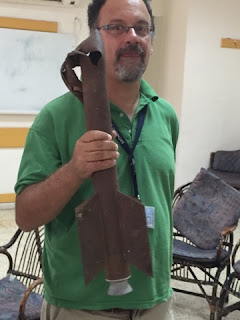Rabbi Gerber wrote this final blog post for our incredible trip to Israel. Even just writing a wrapup post feels surreal; it’s hard to believe how fast this trip FLEW by. It’s been a wonderful “masa” - journey - but all good things must come to an end. Here’s the post for Day Ten:
Our final day in Israel began with a pretty long walk… which surprised no one. Walking was certainly a common activity in most of our days. Muki led us through the streets of Tel Aviv to join a Masorti (Conservative) congregation for Shabbat morning services. After a lovely stroll, we found ourseles at a small congregation in the Neve Tzedek neighborhood of Tel Aviv. Their rabbi was on vacation, so services were lay led. It just so happened that Shabbat coincided with Rosh Chodesh, the start of the new Jewish month of Elul. Whenever Shabbat and Rosh Chodesh fall on the same day (which generally happens a couple of times each year), a special Haftarah is read - and it was my Bar Mitzvah Haftarah a couple of decades ago. It turned out that they were happy for me to chant it, which I happily did. A couple of congregants even threw candy when I returned back to my seat! :-)
After a pretty comprehensive service, we enjoyed lunch in the synagogue building. Another definite non-surprise; it was another wonderful meal, with especially good pareve desserts! It’s been particularly gratifying for me to know that our food and wine tour through Israel has indeed produced some terrific culinary experiences. I had hoped to show our group some of the amazing things Israel has to offer, and the country has come through in spades! Amazing chummus, phenomenal watermelon, delicious cucumbers and tomatoes, surprisingly good sweet red wine (none of us could believe it either!), wonderful meat, fish, and chicken dishes, and so much in between. It really was a very successful trip!
Several of us walked back from synagogue, this time strolling along the boardwalk and seeing all the Israelis and tourists enjoying Tel Aviv’s beautiful beaches. It was a pretty hot day, but a most enjoyable walk nonetheless. Muki stopped to point out a monument, memorializing teenagers killed in a piguah, a terrorist bombing, in 2001. Many of them were Russian Jews, waiting on line to enter a discoteque on a Saturday evening. And then we kept walking along the beach in the warm summer sun. Truly a country of stark contrasts, and somehow you have to reconcile all of them. We felt incredibly safe meandering around the city - both in Tel Aviv and Jerusalem - and yet the threat of Israel’s enemies is never far away. How must it feel to live here and hold these polarities in balance EVERY day??
Back at the hotel, everyone enjoyed a lazy afternoon, taking naps and swimming in the warm Mediterranean. I met up with a friend who had made aliyah, so I sadly did not get to enjoy the water. But overall it was a wonderful way to savor our final day in Israel and just lounge by the beach like the locals do.
After packing up our bus and partaking of one final meal in our hotel, we all made our way back over to the boardwalk for Havdalah and our last farewells. To be honest, I was a little concerned about doing Havdalah by the beach. More than just worrying about keeping our candle lit in the wind (it was fine), I wasn’t sure how awkward it would be to hold a religious ceremony among beach-going, chiloni (secular) Israelis. As always, the locals managed to surprise me yet again. We gathered around in a circle, at a pretty busy intersection, and right away, a few Israelis came over and joined our group! It was so adorable. Unprompted, these young women made sure to first cover up their shoulders (which we found fascinating), and then they joined in with the Havdalah ceremony. And a few others would stop, cover their heads with their hands, and sing along with the tunes. It was already an emotional moment for our group, and now it was yet another reminder of where we were and how different Israel is from any other place on earth. What better way to end our wonderful tiyul (trip)?
After some final hugs and heartfelt thanks to our phenomenal driver, Meyer, and our beyond amazing guide, Muki, half our group got on the bus and headed to the airport. The rest will spend one more day on their own in Tel Aviv, and then return to Philly on Sunday.
I’m writing this final post at cruising altitude on an airplace, three hours away from home. Our “Milk and Honey” trip was over two years in the making. and was once thwarted, last summer, when Israel was in the midst of a war. We had high hopes and expectations, and I think it’s safe to say they were not only met, they were vastly exceeded. My heart is very full, I feel very honored to have spent 10 days with a group of wonderful people in the Holy Land… and I look forward to beginning the plans for our next trip in 2017! :-)
For now, we won't say "goodbye," but rather "L'hitraot," which means "see you soon again."
Warm regards,
Rabbi Gerber



























































